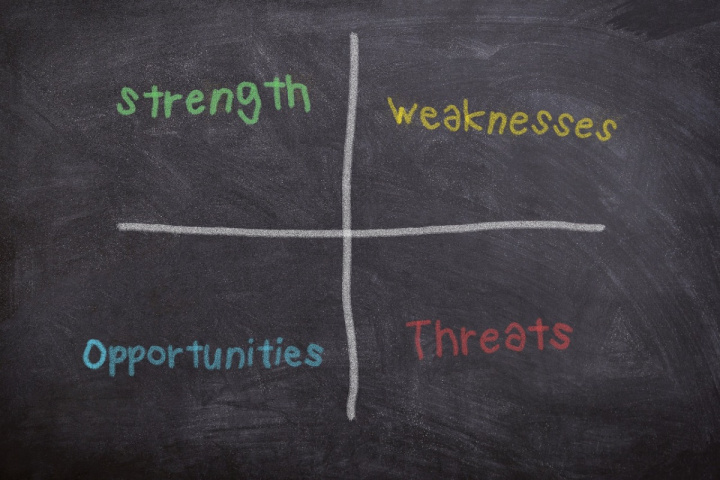What is a SWOT analysis and why is it needed?
In this article, you will learn about what SWOT analysis studies, what elements it consists of, why it is needed, what varieties, advantages and disadvantages it has. We will also talk about how to do a SWOT analysis and apply its results in practice, and we will also give some recommendations on how to conduct it competently.
Content:
1. SWOT analysis - what is it? How and when did it appear?
2. Elements of a SWOT analysis
3. When is a SWOT analysis carried out and why is it needed?
4. Types of SWOT analysis
5. How to do a SWOT analysis and use its results?
6. Recommendations for conducting a SWOT analysis
7. Advantages and disadvantages of SWOT analysis
8. Conclusion
The success of any business in the long run depends on the effectiveness of its planning. To date, there are a number of methods for assessing the activities of companies, among which there are both new and time-tested. One of these classic methods of strategic planning is SWOT analysis, and we will talk about it in our next article.
SWOT analysis - what is it? How and when did it appear?
SWOT analysis is a versatile planning tool that allows you to assess the strengths and weaknesses of an enterprise, its competitors, the industry as a whole based on an assessment of 4 key factors. We will discuss them in detail in the next section of this article.
SWOT analysis was invented by American economists in the second half of the 20th century. The direct authorship of this method of strategic planning belongs to a group of Harvard professors (Leraned, Christensen, Andrews, Guth). They introduced SWOT analysis in 1965 as a strategy for optimizing the business performance of companies.
The method of analyzing the strengths and weaknesses of the enterprise was further developed in the 70s at the Stanford Research Institute. Then a research group was created there under the leadership of Albert Humphrey, which was engaged in improving the SWOT analysis. It developed a method for quickly implementing changes in business processes based on the current goals and objectives of the company. Thus, by the early 1980s, SWOT analysis had become a widespread planning tool. Now it is actively used in various business areas by both small companies and international corporations.

Elements of a SWOT Analysis
This method of strategic planning includes 4 main parameters, which are called the SWOT analysis matrix, as well as the opportunities and threats matrix. Its name is an abbreviation consisting of the first letters of these characteristics. Namely:
- S (Strengths). With this parameter, you can analyze the strengths of the company, providing it with a competitive advantage. Examples of strengths for business are high quality and a wide range of products, a competent marketing policy, etc.
- W (Weaknesses). This criterion demonstrates the weaknesses of the company, which delay its development, limit the growth of sales and profits, make it vulnerable to competitors.
- O (Opportunities). This characteristic reveals the company's capabilities - the same strengths, but due not to internal, but to external factors. In the example of a SWOT analysis matrix, as opportunities, you can indicate a favorable market situation, the emergence of new sales markets, an absent or weak competitive environment, etc.
- T (Threats). Finally, the last criterion in the SWOT matrix is threats. They have much in common with weaknesses, however, just like opportunities, they are caused solely by external factors. These include a variety of environmental elements that can harm the business. For example, it can be a decrease in demand for a product (seasonal or permanent), increased competition, dumping by competitors, the introduction of new taxes, duties or restrictions by the state, an economic crisis, the emergence of substitute products, etc.
Thus, the SWOT analysis matrix consists of two blocks. The first covers internal analysis, during which experts study the company's activities, its products, evaluate the effectiveness of personnel, marketing, logistics and other internal processes. In each of them they look for strengths and weaknesses. and then make recommendations for optimizing the business based on the findings.
The second block is an external analysis: those factors that affect the company's activities from the outside. At this stage, experts examine the opportunities and threats relevant to a particular company or field of activity, and then also produce a report with recommended solutions.
When is a SWOT analysis carried out and why is it needed?
SWOT analysis of an organization allows you to get a real independent assessment of its activities, taking into account all the strengths and weaknesses (internal block), as well as opportunities and threats (external block). Based on this data, they can draw up a plan of action relevant to a particular situation. For example, to decide on the development of new products or the abandonment of existing ones, a change in direction of activity, rebranding, etc.
- Automate the work of an online store or landing
- Empower through integration
- Don't spend money on programmers and integrators
- Save time by automating routine tasks
As for the specific tasks of SWOT analysis, among them are the following:
- Assessment of prospects and market situation. This method of strategic planning helps to conduct a comprehensive analysis of the company in order to assess the demand for the brand and its products / services among the target audience. It can also be used to study the current state of affairs in the industry and adapt to changes in a timely manner.
- Summarizing. Another common task of a SWOT analysis of an enterprise is to summarize its work over a certain period of time. Conducting an independent study will allow you to identify the strengths of the company, along with its existing shortcomings, calculate the growth dynamics for a given period, identify existing opportunities and threats.
- Risk assessment. In addition, drawing conclusions on SWOT analysis makes it possible to assess risks before making important business decisions. For example, before a company enters a new market, releases a new product, launches a new line of business, etc.
- Definition of new steps. An equally important task of SWOT analysis is to find growth points that will help strengthen the company's position in the market and gain an advantage over competitors. These may be unrealized features or existing difficulties/shortcomings (under-optimized workflows, etc.).
Types of SWOT analysis
To date, among economists, three options for implementing this strategic planning tool are common. These include:
- Express analysis. The simplest, most versatile and fastest type of SWOT analysis, which is suitable for different areas and scales of business. It focuses on identifying the strengths of the company, as well as its existing and potential weaknesses. The emphasis is on finding existing advantages and opportunities to improve certain internal aspects of the business. Thanks to which the enterprise can successfully develop and withstand external risks / threats. Distinctive features of express analysis are the speed of compilation and clarity of the data obtained. For example, its results are often presented to investors as a representative report on the performance of a company or project.
- Summary analysis. This is a larger and more detailed method of SWOT analysis. It allows you to get a complete assessment of the company's business performance for a selected period of time (month, quarter, year, etc.) and make a forecast for the future based on the available data. The advantage of this method is that it allows you to get more accurate and detailed conclusions on SWOT analysis, and then quickly move from analysis to the formation of a company development strategy. The disadvantages of the summary analysis include high complexity and duration.
- Mixed analysis. Finally, the third type of SWOT analysis is a combined version, in which there are features of both previous methods. During its implementation, experts conduct at least three different studies, enter their results in a table for cross-analysis of internal and external factors of influence. Quantification is not performed in this case. Mixed analysis is considered to be more detailed/deep than express and less complex/long than consolidated.

How to do a SWOT analysis and use its results?
SWOT analysis can be carried out according to a universal and fairly simple step-by-step algorithm, which includes the following steps:
- Designation of the key goals and objectives of the company or project. Formulation of motives for conducting a SWOT analysis.
- Analysis of the strengths and weaknesses of the organization. To do this, you can try to answer such common questions: what advantages and weaknesses does the company have over competitors, what is its USP, what are the advantages and disadvantages of its products, what internal factors hinder the dynamic development of its business, what can be improved in advertising, marketing, sales, personnel training and its other structural divisions. The resulting information must be sorted in a special table, which will then be used when deciphering the SWOT analysis.
- Analysis of opportunities and threats. At this stage, external factors that can both improve and worsen the company's position in the market are evaluated. Particular attention here should be paid to the analysis of perceived risks that may affect the development strategy of the organization. Further, all identified opportunities and risks are also entered in the table.
- Data matching. After determining all the relevant advantages, disadvantages, opportunities and threats, it is necessary to compare the data obtained by building an example of a SWOT analysis matrix. Thus, you get a number of combinations: SO (what advantages can be used to realize opportunities), WO (what opportunities will help eliminate certain weaknesses), ST (what strengths will protect against possible threats), WT (weaknesses vulnerable to threats and how to reduce their influence).
- Preparing conclusions and developing a strategy. At the final stage, conclusions are prepared on the SWOT analysis based on the received and processed information. In this case, one of two methods can be used: quick viewing or drawing up a matrix, the combinations of which we described in the previous step. As for the quick view, it allows you to highlight the highest priority tasks/problems/directions and concentrate on them. Using one of the two mentioned methods, it is possible to develop a company development strategy, taking into account its advantages, disadvantages, opportunities and threats.
Recommendations for conducting a SWOT analysis
Do not try to do a large-scale analysis of the entire industry at once, instead focus exclusively on your own business, any of its areas or a specific project. Having discarded all unnecessary, you will be able to perform the most accurate and thorough assessment of the company, obtaining the most reliable results. If you also need a SWOT analysis of competitors, we recommend that you prepare it in the course of a separate study.
It is desirable that this study be performed not by one person, but by a group of experts, which will provide more accurate and reliable results. Most often, SWOT analysis is assigned to the marketing department, but you can also add experts from other departments of the company to the analytical team. Working on a SWOT analysis is in many ways similar to brainstorming: the more opinions, arguments and points of view there are, the more complete and objective the picture will be.
When transcribing a SWOT analysis, it is imperative to confirm all its points with real facts and figures. For example, when considering strengths, it is worthwhile to indicate here the current income and profit indicators, the company's market share, the volume of growth of the distributor network, etc. Due to this, SWOT results can be used as an effective tool for strategic planning.

Advantages and disadvantages of SWOT analysis
This method of research has many advantages that have helped it to remain in demand for more than 50 years. These include the following statements:
- Universal business analysis, suitable for companies of any size and field of activity. Using a step-by-step sequence of actions, you can make a SWOT analysis of an online store, a SWOT analysis of an advertising agency, a SWOT analysis of a coffee shop and many other enterprises.
- A comprehensive study covering all the positive and negative, external and internal factors of the company's business activities.
- The simplicity and efficiency of the study makes this method widely available and widespread. Any entrepreneur can perform a SWOT analysis of a small business on their own, without resorting to the services of consultants and analysts. And its results will be understandable and accessible not only to specialists, but to outside observers (investors, partners, etc.).
- To prepare a SWOT analysis, it is not necessary to collect vast amounts of information to perform calculations. It is enough to use the available data about the company, its product, competitors, market conditions, etc.
- SWOT allows you to conduct a structured analysis of the strengths and weaknesses of the company, find ways to eliminate weaknesses using opportunities and neutralize threats using existing advantages.
However, this strategic planning tool also has its drawbacks, among which are:
- The conclusions on the SWOT analysis largely depend on the subjective assessment and opinion of the analyst. Therefore, when conducting this study, it is recommended to collect the largest and most diverse group of specialists, including with the participation of independent experts.
- SWOT reflects the position of the company in a specific period of time, therefore, forecasts made on its basis do not take into account possible internal or external changes. In this case, you need to re-compile the SWOT analysis matrix and draw conclusions.
- SWOT analysis does not involve the calculation of any numerical indicators or the preparation of specific guidelines for action. If you need a detailed business strategy, then you need to create a separate analytical project for this.
Conclusion
SWOT analysis is a strategic planning method that allows you to analyze the strengths and weaknesses of the company, as well as the opportunities and threats that are relevant to it. Based on the data obtained, you can draw up a plan for further business development. SWOT analysis is prepared by a group of specialists during a brainstorming session, while they compile a SWOT matrix and write down conclusions.
There are several types of this study, they include express analysis, as well as summary and combined analysis. The use of SWOT analysis as a planning tool allows you to see the overall picture of all internal and external factors that affect or can affect the development of the company.
Do you want to achieve your goals in business, career and life faster and better? Do it with Apix-Drive - a tool that will remove a significant part of the routine in workflows and free up additional time to achieve your goals. Test the capabilities of Apix-Drive for free - see for yourself the effectiveness of the tool.


